Maintenance Tips
All outdoor park equipment requires periodic maintenance and repairs as the exposure to weather conditions and the human element take their toll. These tips are provided to advise you about what needs to be done, when it needs to be done, and how to do it. These tips may not cover all situations under all conditions, however, we believe they will be useful in a majority of situations.
Charcoal Grills | Campfire Rings | Picnic Table & Park Bench Frame
Picnic Table & Park Bench Top/Seat | Bear Receptacles & Lockers
Firebox Rust
The most common maintenance issue with park grills is rust out at the bottom of the firebox. This occurs where the charcoal fire burns the paint off. Of course, this is directly on top of the support post and swivel mechanism, so when the center of the firebox is compromised by rust, the entire grill can become unusable. This will take a long time to happen, but the problem can be easily minimized to add years to the life of the grill.
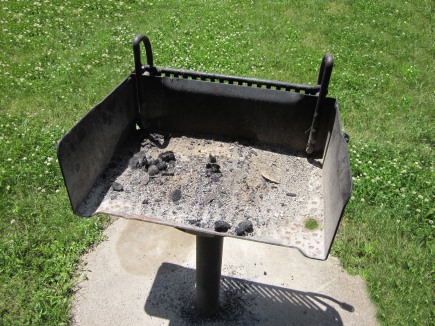 All steel exposed to air and moisture will eventually rust. The rusting process is accelerated where the used coals and ash are left sitting on the bottom of the firebox. A little rain, or water from a lawn sprinkler, added to these ashes will create an alkaline mixture that is highly corrosive to steel. The solution is simple – regularly clean out the used coals and ash from the grills. Use our Model GGS/B-1 Grill and Grate Scraper tool and a metal bucket, or other similar tools. At the end of each park and camp season, you should consider wire brushing and repainting the bottom of the firebox to protect against rusting through the winter months.
All steel exposed to air and moisture will eventually rust. The rusting process is accelerated where the used coals and ash are left sitting on the bottom of the firebox. A little rain, or water from a lawn sprinkler, added to these ashes will create an alkaline mixture that is highly corrosive to steel. The solution is simple – regularly clean out the used coals and ash from the grills. Use our Model GGS/B-1 Grill and Grate Scraper tool and a metal bucket, or other similar tools. At the end of each park and camp season, you should consider wire brushing and repainting the bottom of the firebox to protect against rusting through the winter months.
The non-toxic, high heat paint on the grill/firebox will last one to two years depending on frequency of use and size of fire. When there are signs of rusting anywhere on the firebox, use a wire brush to clean the areas and then spray or brush apply another coat of high heat, non toxic enamel paint. Do this ONLY when there is no fire in your grill and ONLY when the unit has cooled down to air temperature.
Cooking Grate Rust
The cooking grate bars will also rust over time. This is not usually a problem on grills that are used often because the grease and oils from grilled foods coat the grate bars. The grate bars on Pilot Rock charcoal grills are solid steel, so it will take decades for them to rust through. Periodic cleaning is still a good idea. Simply scrape the bars clean with the Model GGS/B-1 Grill and Grate Scraper. Any rusted spots can be cleaned with a wire brush.
A used grate should be cleaned and prepared before the next use. Clean it with the Grill and Grate Scraper and a wire brush to remove any rust. Then thoroughly heat the grate by keeping it low and close to the coals. Finally, raise the grate and scrape it clean again. Alternatively, the grate can be covered with aluminum foil before cooking on it again, or use a pot or skillet to cook food.
On a new grill, the cooking grate should be seasoned before grilling directly on the steel grate. You can season the grate by gradually burning the high heat non-toxic paint off the grate bars as you use the grill. Before you heat the grate each time, you can use a wire brush to clean the grate and remove any paint chips. Until the grate is seasoned, you can use aluminum foil to cover the grate bars, or cook in a metal pan or pot.
Swivel Post Connection Rust
All Pilot Rock charcoal grills include a swivel post connection to the firebox. This allows you to turn the firebox 360 degrees in either direction to compensate for wind. On all brands of grills that include this feature, it is a steel to steel connection. Even in this location underneath the firebox, rusting will eventually occur. If the grills are used and turned regularly, there should be
minimal problems. If the grill sits idle during the off-season, then consider occasionally rotating each firebox on its post to break any rust bond that might be forming. This connection can’t really be lubricated because of the heat from the coals and firebox.
Steel Warp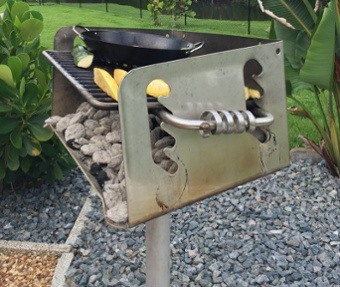
Extremely hot, large or extended fires maintained in the firebox can overheat the box and may cause the steel to warp. Pilot Rock grills include bracing and flanges that are designed to help resist this warping. However, fires that are too large and hot for the grill’s intended purpose, and kept burning for extended periods of time, are outside of the design parameters and can result in steel warping. When this happens, it usually results in the cooking grate being out of alignment, making the grill unusable. The only fix is to replace the entire firebox and grate – and sometimes the base post.
Cooking Grate Rust
Campfire rings that include a cooking grate will experience the same grate issues as on a charcoal grill. The cooking grate bars will also rust over time. This is not usually a problem on campfire rings that are used often because the grease and oils from grilled foods coat the grate bars. The grate bars on Pilot Rock campfire rings are solid steel, so it will take decades for them to rust through. Periodic cleaning is still a good idea. Simply scrape the bars clean with the Model GGS/B-1 Grill and Grate scraper. Any rusted spots can be cleaned with a wire brush.
A used grate should be clea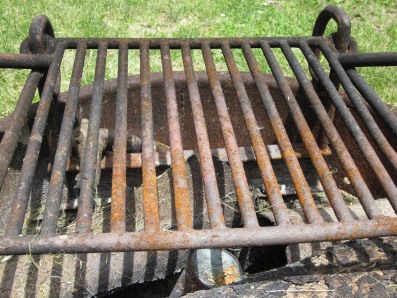 ned and prepared before the next use. Clean it with the Grill and Grate scraper and a wire brush to remove any rust. Then thoroughly heat the grate by keeping it low and close to the coals. Finally, raise the grate and scrape it clean again. Alternatively, the grate can be covered with aluminum foil before cooking on it again, or use a pot or skillet to cook food.
ned and prepared before the next use. Clean it with the Grill and Grate scraper and a wire brush to remove any rust. Then thoroughly heat the grate by keeping it low and close to the coals. Finally, raise the grate and scrape it clean again. Alternatively, the grate can be covered with aluminum foil before cooking on it again, or use a pot or skillet to cook food.
On a new campfire ring, the cooking grate should be seasoned before grilling directly on the steel grate. You can season the grate by gradually burning the high heat non-toxic paint off the grate bars as you use the fire ring. Before you heat the grate each time, you can use a wire brush to clean the grate and remove any paint chips. Until the grate is seasoned, you can use aluminum foil to cover the grate bars, or cook in a metal pan or pot.
Fire Ring Rust
The steel fire ring will begin to rust as the paint coating is burned off over time. Powder coat finishes are not suited for high heat and can burn off with the first fire. Specially formulated high heat enamel paint will last longer. Larger fires and more frequent use will burn off any painted finish sooner.
The rust on the steel ring is not usually a problem and is mostly a cosmetic issue. A steel ring, like the 3/16” thick steel used in many Pilot Rock products, will not rust through for many years. To touch up the paint, remove all ashes and coals from the fire ring. Then use a wire brush to remove as much rust as possible. Lastly, apply a coat of high heat enamel paint. You can paint both the inside and outside surfaces. This will protect the steel ring during the off-season and will prolong the life of the ring.
Ashes will accumulate inside the steel ring. These ashes, when combined with moisture, will create an alkaline mixture that is highly corrosive to the steel. Therefore, ashes must be scooped out of the firering regularly to reduce the damage and prolong the life of the steel. This can be done with our Model FCS-1 firering cleanout shovel.
Pilot Rock campfire rings are designed to sit directly on top of the ground (anchors keep them in place and on site). However, a popular installation alternative is to encircle the steel ring with landscaping blocks or stones. These blocks do serve to disguise and insulate the steel ring. But there is a potential downside to this installation. Ashes and other debris can accumulate on both sides of the steel ring (even a small gap between the blocks and the ring can eventually fill with ash). This means the steel ring can now be subjected to ash and moisture on both sides of the steel at the same time. This will accelerate the corrosive nature of these elements. It is, therefore, even more important to regularly clean out the firering when installed this way.
A similar installation is when the steel ring is buried (partially or completely) into the ground. Now the steel ring is exposed to constant ground moisture on the outside and potentially corrosive ashes plus moisture on the inside. This installation can significantly increase the rusting of the steel ring with failure within just a few years depending on soil type. This installation is not covered by warranty.
Picnic Table & Park Bench Frames
Damage from Moving
If you move or relocate any picnic tables or park benches, look for any frame components that may get damaged during this handling. If diagonal braces that support the frame structure get damaged, they should be replaced to keep the structure sound.
Be sure to check all fasteners. They can work loose over time, especially if the tables or benches are moved around often.
Rust
The most durable frame finish for outdoor furniture is galvanized. A galvanized finish is more durable and resistant to scratching and exposure over time than a painted finish. The best
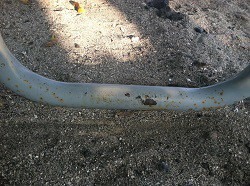
galvanized finish is called hot dip galvanized after fabrication. This process involves submersing the fully assembled frame component into molten zinc to completely coat all surfaces – including the inside and outside of all pipe components and all welds. These dipped components have a shiny finish that will weather to a dull gray over time. This finish will require almost no maintenance under normal use.
There are also frame components made of pre-galvanized steel. These parts are usually lightweight and perform quite well in many applications. However, any areas that have been cut or drilled will expose the underlying steel and may develop rust over time. Be most concerned about any points on pre-galvanized steel that have been welded. The welding heat can burn off the pre-galvanized finish exposing the steel. These weld points must be cold galvanized, which could be equated to a sprayed on painted finish.
Painted frame finishes are also very popular because many color options are available. Most manufacturers now use a dry powder coat paint application process vs. liquid paint. In most common installations, the painted finish will serve well for many years. However, if the paint is chipped or scratched, the exposed metal can begin to rust.
For example, if p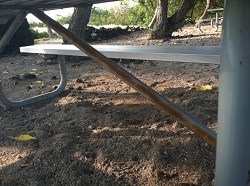 icnic tables are dragged across a concrete surface, the paint can be scratched off the underside of the frame pipe. It won’t be visible on the bottom, but the steel will be exposed. These areas must be sanded and repainted before the rust expands too far. Use any spray paint that closely matches the color of the frame component. You should expect to do more touch up maintenance on painted steel components for park furniture used by the public.
icnic tables are dragged across a concrete surface, the paint can be scratched off the underside of the frame pipe. It won’t be visible on the bottom, but the steel will be exposed. These areas must be sanded and repainted before the rust expands too far. Use any spray paint that closely matches the color of the frame component. You should expect to do more touch up maintenance on painted steel components for park furniture used by the public.
There are, however, environments where painted steel frame components do not hold up as well as galvanized finishes. We do not recommend painted finishes for steel in coastal and island environments, where there is a lot of humidity from the lake or ocean and a lot of salt exposure from that moisture.
The combination of moisture and salt air will cause any steel exposed by a scratch in the paint to quickly rust and the rust will only grow bigger. This can require frequent repair and repainting. The hot dip galvanized finish is less susceptible to this corrosive environment.
Picnic Table & Park Bench Top/Seats
Lumber
Wood top and seat planks will require the most attention to compensate for outdoor exposure. Different species of wood will react differently to the constant variations in sunlight, temperatures, moisture and insects. Warping and weather checking are typically the result.
Pressure treated wood can successfully fight off these abusive elements longer than untreated woods. In general, most lumber should be regularly water sealed or painted to protect from UV rays and moisture. We recommend lumber be inspected and protected annually for best results. Refer to the instructions on the brand of sealant or paint that you decide to use for the species of wood on the picnic table or bench.
On new lumber, you may notice grading stamps. All lumber is graded and grading stamps on the lumber are common and unavoidable. If these grading stamps are objectionable, you can remove them by sanding the lumber. The stamps will also likely fade over time from weather exposure.
Recycled Plastic
The 100% recycled plastics are impervious to the weather elements and insects. They include a UV stabilizer for UV protection. They are resistant to mold and chemicals, and will not splinter or rot. Recycled plastic is a great material for many locations. Cleaning is the most common maintenance need. The solution is as simple as washing off any accumulated grime.
Recycled Plastic Graffiti Removal
One maintenance challenge is the removal of graffiti. There are several graffiti removal tools on the market that can be used on Pilot Rock plastic components. Harsh graffiti removers like MEK, NexGen and gasoline solutions will not harm the plastic. Be sure to wash off any residue.
Pressure washing with a detergent added will also remove most dirt, grime, debris and 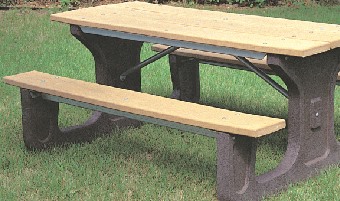 markings, like graffiti. When pressuring washing, start with the washer tip far away, and then gradually move closer to the plastic lumber. This will avoid gouging the plastic with too aggressive of a pressure wash. If the substance is ground in, oily or sticky, some type of solution will be needed to loosen up the stain and get it out of the texture surface.
markings, like graffiti. When pressuring washing, start with the washer tip far away, and then gradually move closer to the plastic lumber. This will avoid gouging the plastic with too aggressive of a pressure wash. If the substance is ground in, oily or sticky, some type of solution will be needed to loosen up the stain and get it out of the texture surface.
Recycled plastic components can also be damaged by high heat. Charcoal or gas grills should not be used directly on plastic picnic table tops. Hot cooking pans also should not be placed directly on top of plastic planks. The heat can deform the plastic. If the plastic plank is warped by heat, it will probably have to be replaced with a new piece.
The recycled plastic is dense and durable, but vandals can deface it with sharp knives. If something has been carved into a plastic surface, it can usually be removed by applying heat, such as a small torch, and smoothing the surface with a putty knife. Heat the surface just enough to soften the plastic so you can smooth it over. The repaired area will be obvious but at least an inappropriate word will not be readable anymore. The repair will last until you can replace the component with a new piece.
Aluminum
Aluminum components do not suffer from exposure to sunlight, insects, moisture or temperature. Rusting and rotting are not issues here. One maintenance concern could be caused by the lightweight nature of these products. For example, aluminum picnic tables are easier to move around. So periodically check all the fasteners to be sure that the product structure is tight and secure for public use. Aluminum components can easily be kept clean with water and a mild detergent.
Thermoplastic Coated Steel
As long as the thermoplastic coating is not damaged and remains intact, these components can easily be cleaned with water and a mild detergent. The coating includes a UV stabilizer so the effects of constant sun exposure will be reduced and delayed.
However, the thermoplastic coating can be damaged by high heat or vandalism. Charcoal or gas grills should not be used directly on picnic table tops. Hot cooking pans also should not be placed directly on top of the thermoplastic coating. The heat can deform the coating. Vandals can deface the coating with sharp knives, fire or enough determination. If the steel core is exposed, it will be subject to rusting. Most manufacturers of plastic coated steel components can supply repair kits for small damaged areas. The patched area will not exactly match the original coating, but the steel core will be covered and protected.
Vandalism is always a maintenance issue for picnic tables -- even steel tables. Expanded steel and perforated steel materials don’t provide a lot of strength by themselves. The strength of these steel table components is in the substructure that supports the top and seat material. Some designs are stronger than others and hold up better under public exposure. A simple act of vandalism (like a person jumping from the table top to the seat) can damage the seat on weak designs and make a steel table unusable. Repair of such damage will require replacement of the damaged table component.
Powder Coated Steel
Powder coated finishes are very durable and capable of withstanding exposure to weather elements and sunlight for many years. However, public use will eventually result in nicks, chips and scratches to the paint surface. If the damage is deep enough to expose the steel structure then rusting will begin. These damaged areas should be repaired as soon as they are discovered. Most outdoor furniture manufacturers can provide touch up paint. Prepare the damaged area by sanding and cleaning the surface before applying paint. New paint likely won’t match the weathered paint exactly, but it will look better than ever-expanding rust spots.
Hinges & Latches on Bear Resistant Trash Receptacles and Food Lockers
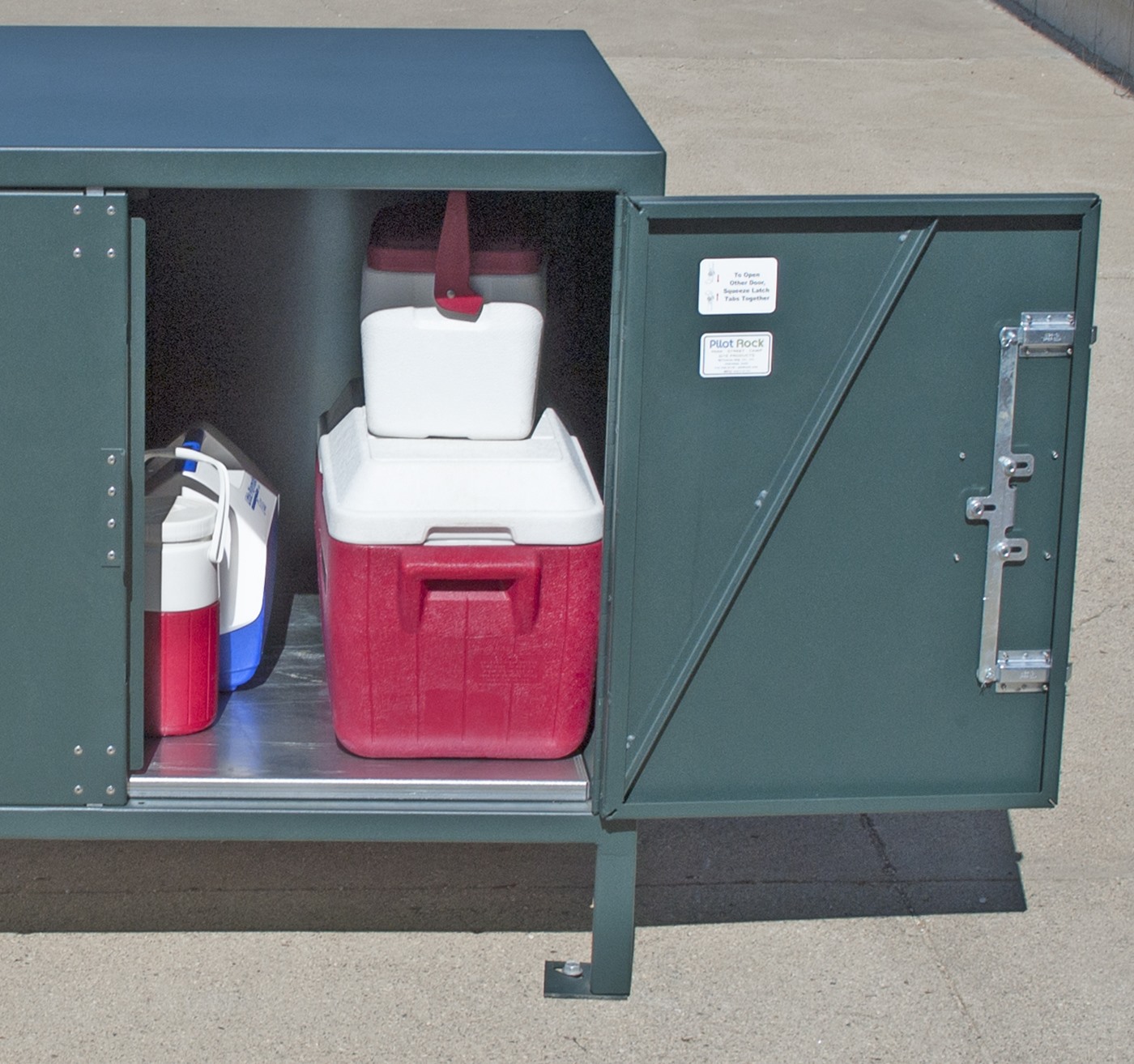
We recommend lubricating the hinges and latches at least twice a year – perhaps in the Spring before the busy park and camping season reopens, and again in the Fall as the season is closing down. This lubrication will keep the components working and prevent rusting during the down time. Apply your choice of lubricant to all top hatch hinges and door hinges, and be sure to generously lubricate the latch mechanisms. We suggest twice a year lubrication as a minimum maintenance routine. Your local environment, weather conditions and frequency of use may require more frequent lubrication.
When performing this lubrication maintenance, it’s also a good time to check the instructional and safety decals on the doors and hatches. You can order replacements when needed.
